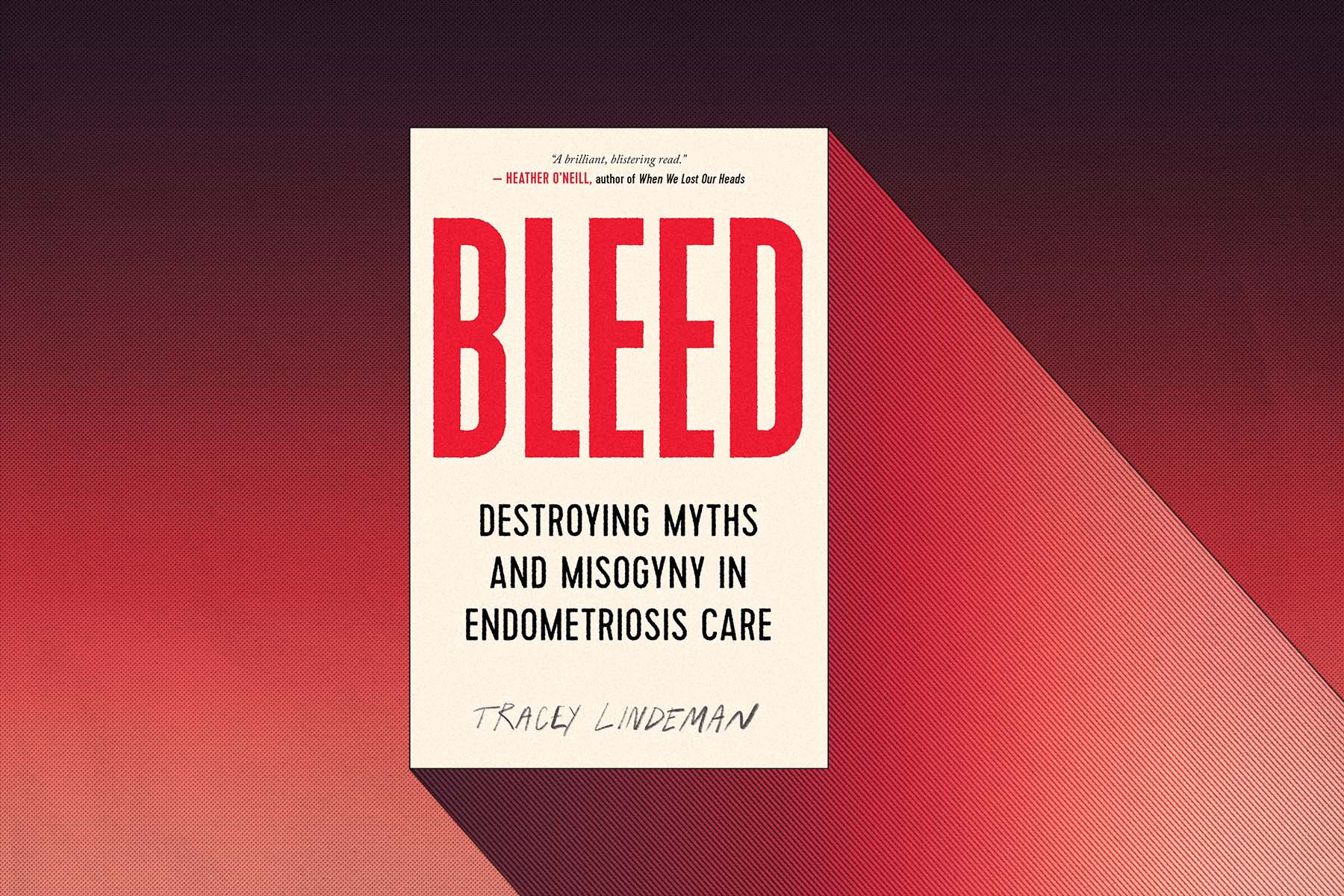I had been in labour for twenty-five hours and was actively trying to push out my son when I noticed a male doctor standing half in shadow in the far corner of the birthing room, holding a giant pair of scissors. At this point, the doctors and nurses around me were starting to get concerned about the baby’s dropping heart rate, but there was little communication about additional interventions.
I knew from reading economist Emily Oster’s work (2014’s Expecting Better, 2019’s Cribsheet) in the nine months leading up to this moment that vaginal trauma can be much more likely in the event of an episiotomy—the widely feared incision of the perineum that can help the baby come out. I knew that although the procedure used to be common, its routine use is no longer recommended by medical organizations. More importantly, I knew what I wanted for my own body.
Nobody around me seemed to be having a similar academic revelation; in fact, the man with the scissors just kept inching further into the room. I quickly realized that he was the same man I had asked to leave the birthing room several hours earlier after he performed one too many rough cervical exams without even a word of warning. “Honestly, guys,” I said in between gasping breaths, “what the fuck is he doing here?”
Nobody can prepare you for how it feels when a health care professional ignores your pain or your concerns—even when you’re familiar with the literature, have heard and read countless anecdotes, and have experienced this personally to the point that you have become trained to expect it. In her new book, Bleed: Destroying Myths and Misogyny in Endometriosis Care, journalist Tracey Lindeman chronicles her own and others’ experiences living with endometriosis and the Sisyphean task of getting basic acknowledgement of their suffering—never mind adequate care. With at least 190 million people around the world currently suffering from it, according to the World Health Organization, endometriosis has become a case study for how the medical system fails women in exactly this way. (When I use “women” here, as Lindeman does, I’m referring to all women, not just those assigned female at birth.)
As Lindeman writes, endometriosis is “a disease defined by the growth of endometrial-like tissue outside the uterus. These growths—called endometriomas, lesions and adhesions—attach to ovaries, fallopian tubes and the exterior of the uterus, as well as the bowel and sometimes as far away as the kidneys, diaphragm, lungs and in rare cases, the brain.” Endometriosis is a chronic, often debilitating condition. The tissue growths, despite being outside the uterus, act just as endometrial tissues do: they thicken, break down, and bleed with each menstrual cycle. There is no naturally occurring biological process to rid the body of these rogue tissues or defend it against the damage they can inflict. Symptoms vary widely but can often include heavy and painful periods, scar tissue, adhesions (bands of scar-like tissue that can cause internal organs to stick together), pain during sex, difficulty with bowel movements and urination, reduced fertility, and severe pelvic pain. “Some people don’t know they have it. Others know they have it but haven’t persuaded the right people to give them a diagnosis,” Lindeman writes. “In North America, and much of the Westernized world, people spend an average of seven to ten years trying to get properly diagnosed.” Unsurprisingly, women of colour face an even steeper uphill battle when it comes to getting their pain taken seriously.
Bleed is part memoir, part history, part investigative journalism—and all searing, acerbic prose. Lindeman includes stories of other people suffering from endometriosis, following each experience so closely that it feels like learning about a friend’s painful, secret second life. She skillfully connects their journeys with recent data on the costs and efficacy of and the trade-offs necessary to pursue pain medication, birth control, hormonal modulators, or surgery as treatment options. Along the way, she clocks the consequences of gatekeeping in medicine and of pharmaceutical-company corruption.
In a climate where abortion and contraceptive access in the United States are under more threat than they have been in fifty years—and at a time when nobody can afford to mince words about women having access to the care they need and deserve—Bleed arrives in full force, exposing the raw and isolating experience of living with a feminized disease in a world that doesn’t want to acknowledge women’s pain. Lindeman does a great service to her readers by showing them they are not alone in their struggles and by sharing everything she has learned about how best to navigate the health care system, but she stops short of giving false hope. “I wish I could tell you that being an empowered patient gets me respect or better treatment,” Lindeman writes, “but it doesn’t.”
I don’t have endometriosis but do have polycystic ovarian syndrome (PCOS), so I understand what it means to live with pain that is misdiagnosed, minimized, and, frankly, dismissed as a figment of my imagination. Like endometriosis, PCOS is a condition that primarily affects women, and as such, the research around causes, treatment, and cures is chronically underfunded. “This problem runs all the way through research into women’s health,” writes Angela Saini, author of Inferior: How Science Got Women Wrong—and the New Research That’s Rewriting the Story. “If a phenomenon affects women and only women, it’s all too often misunderstood.”
This is a well-established problem in medicine, where conditions and diseases that primarily affect men are given more attention and funding than those affecting women, and the consequence is that doctors often don’t know how to diagnose the latter—if they even believe you are sick in the first place. But the problem began much earlier, with modern medicine being developed with male physiology as the default. This underrepresentation in the research has resulted in poor understanding of how women’s bodies work and respond to treatments, which in turn has led to misdiagnosis, inappropriate treatment, and lack of access to effective care. For instance, women more frequently than men present with nausea and indigestion before and at the onset of a heart attack, symptoms that are considered “atypical” because research based on male physiology found hallmark symptoms to be pain or discomfort in the left arm and chest. As a result, women have been found to be 50 percent more likely than men to be misdiagnosed following a heart attack and more likely than men to die from heart attacks.
Studies suggest that gender bias in medicine often leads to female patients being denied pain relief for a range of health conditions. A US analysis of 981 emergency-room visits showed that women with acute abdominal pain were 13 to 25 percent less likely than their male counterparts to be treated with opioid painkillers. According to an article on Harvard University’s website, “Women in pain are much more likely than men to receive prescriptions for sedatives, rather than pain medication, for their ailments.” And sometimes they’re much less likely than men to be prescribed painkillers after surgery.
Many women are leaving health care interactions feeling neglected, uncared for, and, worst of all, being made to feel like their pain, their concerns, and their knowledge about their own bodies aren’t real or relevant. If it goes on long enough, that kind of strain will take you down one of two roads: giving up entirely on seeking help and living in depression and collapse, or in a state of fight, jacked up on the cortisol and stress.
After so many years of struggling to get her pain acknowledged and her endometriosis under control, Lindeman ended up in the latter category—she felt like a cornered animal any time she walked into a doctor’s office: “I’d been gaslit for so long that every new doctor felt like a new adversary, someone I had to fight.”
With the sound of my angry question ringing in the air, the medical staff in the delivery room barely raised their heads from their work. “Oh, he’s just here in case we need him,” one of them said reassuringly, fussing with my IV. “Nothing is happening yet.” I was furious. I gripped the sides of the hospital bed, hauled myself a little more upright, and screamed, “I want that man out of here right now! Right now! He is not coming anywhere near me. Get me another doctor right now and explain to me what is going on.” I kept screaming for what felt like many long minutes, demanding to know what was about to happen to my body, but I suppose a woman screaming in a birthing suite is so expected that the actual words I said didn’t register.
It wasn’t until my partner (a man), who was sweating from an hour of holding my legs back as I tried to push our son out, quietly said, “I think she just wants a little more communication from you guys. Maybe just let her know what your plans are and have a quick conversation first?” that, suddenly, there was a flurry of activity.
A different doctor, a woman, approached my bedside and looked me in the eye, her expression soft. “I’m going to explain your options to you,” she said calmly. “We are getting concerned about the baby’s decelerating heart rate. We can see him, he’s crowning, but you’ve been pushing for almost two hours now and the birth isn’t progressing.” She paused. “First:” she said, “we can perform the episiotomy to help the baby come out.”
“No,” I said firmly.
“Second: we can have you push a little longer with some adjusted breathing techniques.”
“Fine.”
“If the pushing doesn’t progress and his heart rate continues to decelerate, we can use a vacuum extractor.” I considered this, knowing that this type of intervention would increase my chances of having more severe vaginal tearing, while also factoring that I hadn’t felt my son’s ninety-eighth-percentile-sized head move in the past two hours. “Okay, I’m good with that,” I said.
Around thirty minutes later, my eight-pound, ten-ounce son was born via vacuum extraction, with the umbilical cord wrapped around his little neck. I was so relieved to see him when he was placed on my chest that it took a few minutes before I looked down and realized Scissor Man was sitting sullenly between my legs, sewing me up. I lay back, resigned, and let him finish.
A couple of years ago, veteran journalists and colleagues Maria Aspan and Erika Fry started having conversations about a theme that kept emerging in their reporting: “Why is women’s health so under-researched, underfunded, and underserved?” Their curiosity about these questions helped them secure a grant from the National Institute for Healthcare Management (NIHCM) Foundation for a series of articles. What they found painted a bleak picture:
Women account for more than half of the population [in the US] and 80% of all health care purchasing decisions. They take more prescription drugs than men do and more often go to the doctor. But despite their market power, women have largely been treated like an afterthought or inconvenience—at best—for the $4.3 trillion [in 2021] American health care market. Only 5% of all biopharma R&D spending goes towards female-specific conditions, most of which are cancer-related. (Take out oncology and it drops to 1%.) A paltry 13 percent of cardiovascular clinical trial participants are women, even though heart disease is the leading cause of death for women in the US. And for all the buzz about femtech, the numbers aren’t better in the start-up ecosystem: In 2021, women’s health accounted for only 5% of all digital health investment in the United States.
When clear, capitalistic information like this demonstrates that women are an attractive market but hardly anyone is tripping over themselves to make a dollar, you start to wonder what other forces are at play. If you are a woman and you sit with that question long enough, you know the truth at the heart of it is in the history of subjugation of your gender, a subjugation that continues today. And if you are a woman and you sit with those thoughts long enough, a deep-seated anger roils inside you that is difficult to quiet. “So often we are told to lie back and take it,” Lindeman writes with power and precision in Bleed. “We must accept the things we cannot change, lest our anger consume us. But why not be consumed? There is a certain utility in consumption. When focused, anger can be a catalyst and an engine for change. The systems that oppress us benefit from our silence and compliance, and they make us complicit in our own abuse by forcing us to engage on their terms.”
There is a seething, surging anger that radiates from every sentence in Lindeman’s book. Reading it, I felt as if the author was standing inches away from my face and screaming into it. Initially, I recoiled. I was wholly uncomfortable with her bold expression. I even chastened her in my mind for not finding another way to relay her story. By the end, though, I came to realize that the tenor and pitch of her writing exactly matched the tenor and pitch of the anger that flared and faltered inside me when I sat with my own experiences.
When I tell my birthing story to friends or family, I like to tell it like I had a baby in a boxing ring: advocating loudly and successfully for myself, fighting off negligent medical professionals with the same athletic stamina that carried me through twenty-six hours of labour. I went into the experience expecting my concerns to be disregarded (and knowing that being biracial wasn’t going to help my chances) so I felt prepared, and maybe even a little excited, to meet the challenge. But the truth, once it was written down, was very different. I had to face the reality of my experience in order to accurately portray it: I fought valiantly and accomplished something incredible, but I was still vulnerable. I still needed my partner to advocate for me in order to have my needs met and my voice heard, and that knowledge is uncomfortable to hold.
There is a strong possibility that some readers will see the bold, red capital letters of the title of Lindeman’s book in bookstores and turn away. The book is an evidence file for female pain, and the idea that women exaggerate their pain has been used to override women’s complaints for centuries and continues to inform how any expression of strong emotion is perceived. There is another possible world where people who are living with endometriosis—or any other condition that affects female bodies—will pick up the book and see themselves and their suffering reflected in its pages, and that will be meaningful. Considering the potential impact of Lindeman’s book reminded me of a passage in Rebecca Solnit’s book Hope in the Dark about how the project of writing and sharing your work with the world is akin to the idea of hope, because both happen in a space of uncertainty:
An essay, a book, is one statement in a long conversation you could call culture or history; you are answering something or questioning something that may have fallen silent long ago, and the response to your words may come long after you’re gone and never reach your ears, if anyone hears you in the first place . . . This is a model for how indirect effect can be, how delayed, how invisible; no one is more hopeful than a writer, no one is a bigger gambler.
The positive consequences of our actions are not always immediately measurable. What gives me no small measure of hope is that there are people like Lindeman who are willing to hone and direct their angry energy into something useful, even if they won’t see the fruits of their labour themselves. That in itself is an act of hope. As Lindeman herself writes: “Anger is a power plant that can generate energy that spurs us to action. You can use it to make a difference—if not for yourself, then for someone else.”





